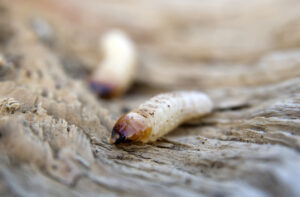
Need Help? Call Us On 0161 776 9832 For Expert Pest Control Advice On How To Identify Pest Infestations And Help Solve Your Pest Problem.
Professional Northwich Woodworm Treatment
The term "woodworm" refers to the larval stage of various wood-boring beetles. Although beneficial in their natural woodland environment, helping with the decomposition process of deadwood, they are a serious pest when they affect wooden furniture or buildings.
Any rotting wood foraged from the wild can contain woodworm. The use of greenwood, popular as structural timber, may also be infested with woodworm, a condition that may not become apparent until years later when imaginal (adult) beetles emerge. Flying beetles can enter a building the same way as other winged insects.
Woodworm in furniture
 Many an item of wooden furniture has been ruined by woodworm activity. Often, the presence of woodworm in furniture is indicated by the accumulation of wood dust, or frass, underneath it and crumbling around the edges. Exit holes of around 1-2 mm appear in the wooden surfaces of the furniture when the imaginal beetles emerge.
Many an item of wooden furniture has been ruined by woodworm activity. Often, the presence of woodworm in furniture is indicated by the accumulation of wood dust, or frass, underneath it and crumbling around the edges. Exit holes of around 1-2 mm appear in the wooden surfaces of the furniture when the imaginal beetles emerge.
Northwich woodworm treatment furniture spray, applied by professional pest control services, will kill any woodworm inside wooden furniture. Furthermore, furniture can be protected from future wood-boring insect attacks by applying Northwich woodworm treatment furniture spray.
Woodworm in structural timber
The presence of woodworm in a building's structural timbers can cause significant damage. Anyone who has seen woodworm holes in old wooden beams knows that these destructive pests can ruin timber aesthetics. In the more advanced stages of woodworm infestation, the structural integrity of-of buildings can be compromised.
Professional Northwich woodworm removal can save buildings from the destruction associated with advanced woodworm infestation. In addition, professional pest control services can help prevent future attacks of wood-boring beetles with pre-emptive Northwich woodworm treatment spray.
Woodworm varieties
 The Deathwatch beetle (Xestobium rufovillosum) is a notorious culprit involved in woodworm activity. This species is often associated with old buildings. The imaginal beetles may be heard the clicking or knocking in the rafters of old buildings. Thought to be a bad omen, the sound is due to mating rituals.
The Deathwatch beetle (Xestobium rufovillosum) is a notorious culprit involved in woodworm activity. This species is often associated with old buildings. The imaginal beetles may be heard the clicking or knocking in the rafters of old buildings. Thought to be a bad omen, the sound is due to mating rituals.
The Common Furniture Beetle (Anobium punctatum) is the most prolific of wood-boring beetles involved in woodworm activity in buildings. Consequently, the majority of professional Northwich woodworm treatment is in response to the activities of this nuisance species.
The Powder post beetle (Lyctus brunneus) is one of the most destructive species of wood-boring beetles. As its name suggests, the larva is capable of reducing sapwood to powder. Therefore, swift treatment for woodworm removal is essential to prevent widespread devastation of timber when this species infests a property.
The Wood-boring weevil (Pentarthrum huttoni) prefers damp and rotting wood. A common route of infestation for this species is through decomposing wood picked up off forest floors. If the conditions are right, the infestation will spread throughout a building.
The Old-house borer (Hylotrupes bajulus) is a species of Longhorn beetle. Although not as common as other wood-boring beetles, it is one of the most destructive due to its large size and its ability to re-infest the same wood from which it emerged.
CW8
CW9
